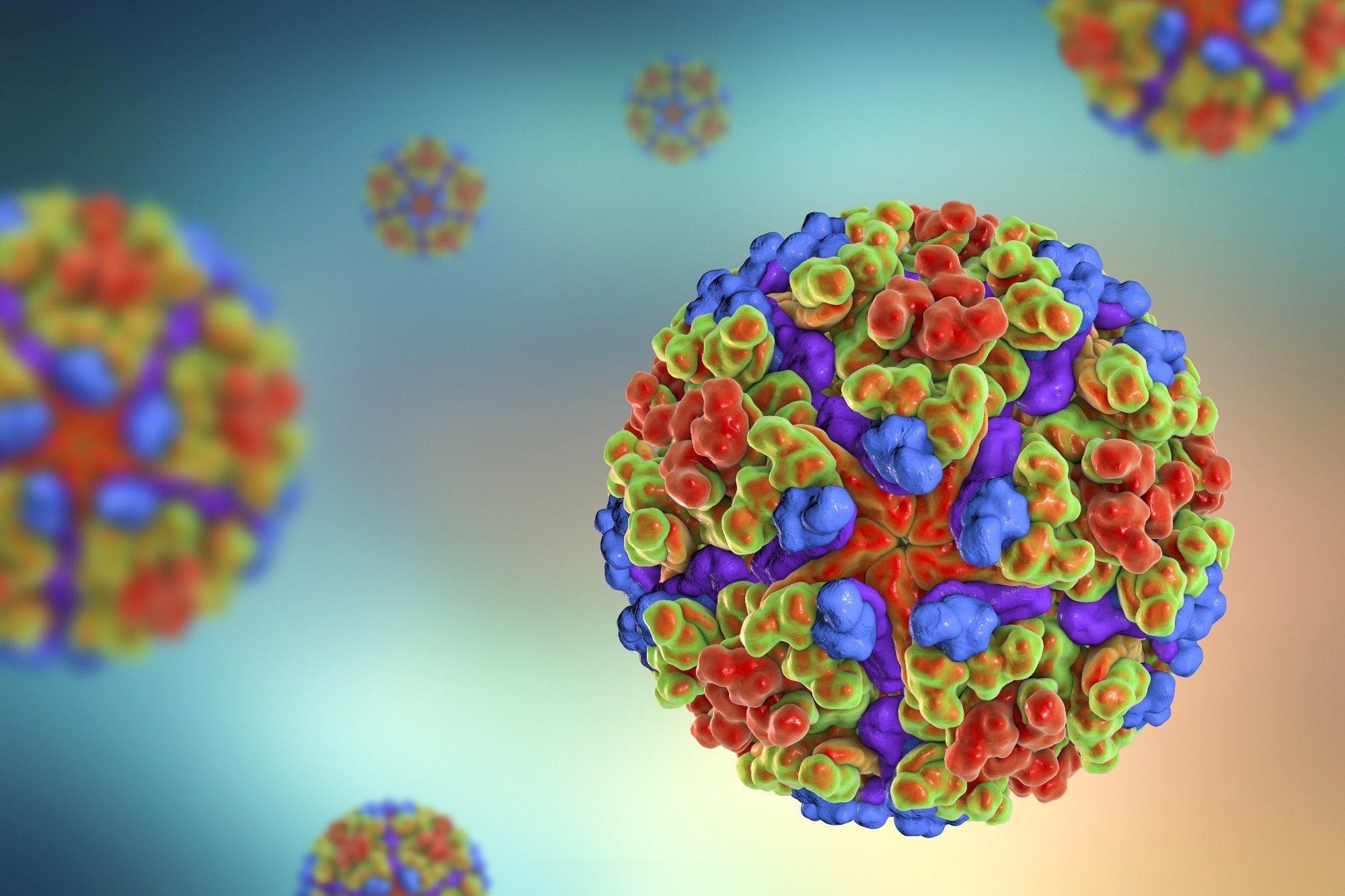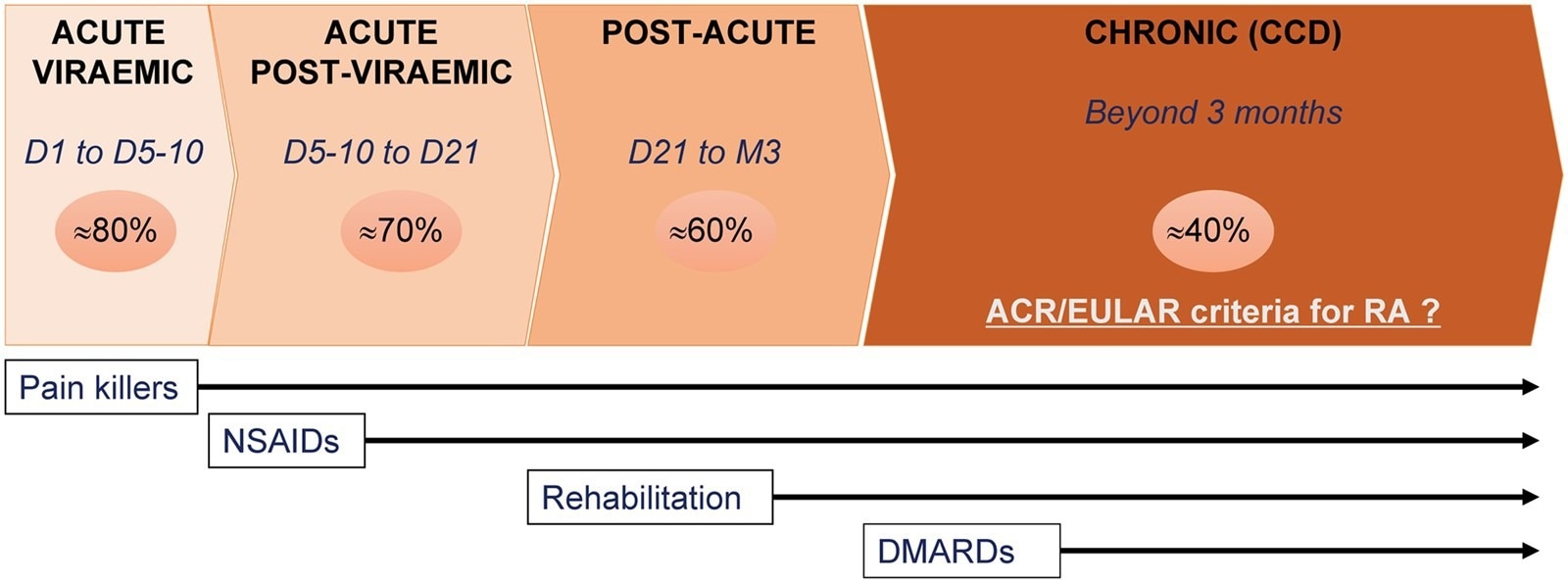Introduction
History, Epidemiology, and Recent Outbreaks
Molecular Virology and Evolution
Transmission and Vector Ecology
Clinical Features
Chronic and Long-Term Manifestations
Complications and Mortality
Diagnosis and Differential Diagnosis
Treatment and Management
Prevention and Vector Control
Vaccines and Research Directions
Burden and Economic Impact
Conclusions
References
Further reading
Chikungunya is a mosquito-borne viral disease that causes acute and chronic joint pain, fever, and other severe symptoms. The article provides a comprehensive overview of its global spread, clinical features, complications, and prevention strategies.
 Chikungunya virus, 3D illustration. Image Credit: Kateryna Kon / Shutterstock
Chikungunya virus, 3D illustration. Image Credit: Kateryna Kon / Shutterstock
Introduction
Chikungunya is a globally significant viral disease caused by the Chikungunya virus (CHIKV), an arthropod-borne alphavirus primarily transmitted to humans by Aedes mosquitoes. The disease is characterized by fever and severe joint pain, but its clinical spectrum ranges from acute to chronic and can involve a wide range of complications. First described in 1952 during an outbreak in southern Tanzania’s Makonde Plateau, the name "chikungunya" is derived from the Makonde language, meaning "that which bends up," reflecting the contorted posture of those suffering from its incapacitating arthralgia.[1]
History, Epidemiology, and Recent Outbreaks
Since its initial identification in Africa, chikungunya has undergone periodic, sometimes explosive, outbreaks, spreading to Asia in the 1960s, and re-emerging in the Indian Ocean region in the early 2000s. The 2005–06 Réunion Island epidemic infected nearly one-third of the island’s population and highlighted the virus’s ability to adapt to new mosquito vectors and environments.[1],[4] The E1-A226V mutation, which enhances replication in Aedes albopictus, was a key driver in this spread.[5]
Chikungunya reached the Americas in 2013, and within a decade, over 3.7 million suspected or confirmed cases were reported across 50 countries and territories. Large outbreaks have since occurred in Brazil, the Caribbean, and the southern United States, fueled by global travel, urbanization, and climate-related changes that expand Aedes mosquito habitats.[7],[4] Local transmission has been reported in at least 119 countries.[7] Underreporting is common, particularly in rural or low-resource settings.
As of August 2025 numerous southern Chinese cities have seen more than 7,000 cases of the chikungunya virus. The majority of the cases were in the Shunde district of Foshan when the outbreak started in China in late July.
Molecular Virology and Evolution
CHIKV is a single-stranded, positive-sense RNA virus about 60–70 nm in diameter. Its genome encodes four nonstructural proteins (nsP1–nsP4) for replication, and three major structural proteins (C, E1, and E2), with E1 and E2 glycoproteins playing a central role in host cell entry and immunogenicity.[9] The E1-A226V mutation in the ECSA (East-Central-South-African) lineage improved the virus’s ability to infect Aedes albopictus and contributed to its pandemic potential.[5]
Three major CHIKV lineages have been identified: West African, ECSA, and Asian. Both urban (human-mosquito-human) and sylvatic (mosquito-nonhuman primate-human) cycles contribute to virus persistence and emergence.[3],[4]
Transmission and Vector Ecology
Transmission occurs through bites of infected female Aedes mosquitoes, especially Aedes aegypti and Aedes albopictus. Aedes aegypti is highly adapted to urban environments and prefers feeding on humans, while Aedes albopictus thrives in both tropical and temperate climates due to its cold-resistant eggs, allowing it to overwinter and expand globally.[2],[4]
Other Aedes species (such as Aedes furcifer and Aedes africanus) are important in sylvatic cycles. Rare transmission can occur via blood transfusion, and vertical (mother-to-child) transmission has been documented, especially during childbirth.[3],[2] Although sexual transmission has been proposed, it has not been definitively confirmed.[3]
Environmental factors, including temperature, rainfall, urbanization, and human mobility, all shape epidemic risk and virus adaptation. Higher temperatures accelerate viral replication in mosquitoes and expand the geographic range of Aedes vectors, potentially increasing the risk of outbreaks in previously non-endemic areas.[2],[4]
![The chikungunya virus replication cycle includes (1) virus binding to a specific receptor in the membrane, (2) clathrin-mediated endocytosis, (3) membrane fusion, (4) capsid disassembly, (5) translation, (6) processing, (7) replication, (8) 26’s subgenomic RNA translation, (9) autoproteolysis, (10) cleavage in the endoplastic reticulum and initial folding, and (11). Glycosylation and structural conformation, (12) migration to the plasma membrane, (13) nucleocapsid assembly, and (14) the release of new viruses (Created by using Biorender.com).[9]](https://www.news-medical.net/images/Article_Images/ImageForArticle_332_17544542793445527.jpg) The chikungunya virus replication cycle includes (1) virus binding to a specific receptor in the membrane, (2) clathrin-mediated endocytosis, (3) membrane fusion, (4) capsid disassembly, (5) translation, (6) processing, (7) replication, (8) 26’s subgenomic RNA translation, (9) autoproteolysis, (10) cleavage in the endoplastic reticulum and initial folding, and (11). Glycosylation and structural conformation, (12) migration to the plasma membrane, (13) nucleocapsid assembly, and (14) the release of new viruses (Created by using Biorender.com).[9]
The chikungunya virus replication cycle includes (1) virus binding to a specific receptor in the membrane, (2) clathrin-mediated endocytosis, (3) membrane fusion, (4) capsid disassembly, (5) translation, (6) processing, (7) replication, (8) 26’s subgenomic RNA translation, (9) autoproteolysis, (10) cleavage in the endoplastic reticulum and initial folding, and (11). Glycosylation and structural conformation, (12) migration to the plasma membrane, (13) nucleocapsid assembly, and (14) the release of new viruses (Created by using Biorender.com).[9]
Clinical Features
The classic presentation includes an abrupt onset of high fever, severe polyarthralgia, myalgia, headache, and a maculopapular rash. Up to 90% of patients experience joint pain, and 88% have fever during the acute phase, which typically lasts 7–10 days.[7] Headache, nausea, fatigue, and rash are also common.[1]
Children, neonates, and elderly adults are at greater risk for severe or atypical disease. In pediatric populations, neurologic complications, such as encephalopathy, seizures, and long-term cognitive impairment, are increasingly recognized. Perinatal transmission can cause severe neonatal illness, including intracerebral hemorrhage and neurologic sequelae.[2]
Chronic and Long-Term Manifestations
While most patients recover fully, an estimated 40%–60% of affected individuals develop persistent arthralgia, joint pain that can last months or even years after initial infection.[3],[5],[7] This chronic phase may resemble autoimmune rheumatic diseases, such as rheumatoid arthritis or spondyloarthropathies, and often requires specialist input.[1]
The pathogenesis of "long chikungunya" involves immune-mediated mechanisms, including persistent local infiltration of CD4+ T cells, activation of Th17 pathways, and the secretion of pro-inflammatory cytokines in synovial tissue. Viral antigen persistence may also play a role, even when the active infection has resolved.[3],[5] Ocular complications (e.g., uveitis, retinitis), myocarditis, and neurological manifestations are rare but can occur.[1]
The chronic burden of chikungunya is substantial, leading to disability, absenteeism, and significant economic costs. Recent global estimates attribute around 1.95 million disability-adjusted life years (DALYs) to chikungunya, with three-quarters resulting from chronic disease and its sequelae.[7]

Stages of chikungunya disease are represented with globally estimated prevalence (% in circles), CDD for chronic chikungunya disease, D for days, and M for months. The time for the introduction of therapeutic strategies is represented under the graph with NSAIDs for non-steroidal anti-inflammatory drugs, DMARDs for disease-modifying anti-rheumatic drugs. American College of Rheumatology (ACR) and European League Against Rheumatism (EULAR) are diagnostic criteria for rheumatoid arthritis (RA).
Complications and Mortality
Most patients survive, but severe complications are increasingly recognized, especially during large outbreaks or in individuals with comorbidities, immunosuppression, or at the extremes of age.[8] Reported mortality rates range from 0.1% to 0.7%, with higher rates among older adults and infants.[7] Serious complications may include myocarditis, hepatitis, encephalitis, and multi-organ dysfunction.[1],[2]
Diagnosis and Differential Diagnosis
Diagnosis is based on clinical suspicion, especially in endemic regions or during known outbreaks. Laboratory confirmation involves:
- RT-PCR for viral RNA detection (most sensitive in the first 5–10 days, during the acute/viraemic phase)[9]
- Serology (IgM, IgG by ELISA) for cases after the acute phase[9]
Because chikungunya’s clinical presentation overlaps with other arboviral infections (especially dengue and Zika), simultaneous testing is advised in febrile patients from endemic regions.[1],[9] The differential diagnosis also includes malaria, leptospirosis, hepatitis C, and rheumatic diseases.[1]
Treatment and Management
No specific antiviral treatment exists for chikungunya. Management is supportive:
- Analgesics (paracetamol/acetaminophen) and NSAIDs (e.g., ibuprofen) provide symptom relief
- NSAIDs and aspirin should be used with caution and avoided until dengue is excluded, due to bleeding risk[1]
- Corticosteroids and disease-modifying antirheumatic drugs (DMARDs) may be indicated for chronic, refractory arthritis[1],[3]
- Hydration and rest are universally recommended
New therapies, including monoclonal antibodies and antivirals, are under investigation but are not yet standard of care.[9]
Prevention and Vector Control
The most important strategies for prevention include reducing mosquito breeding sites (elimination of standing water), using insect repellents, wearing protective clothing, and screening of dwellings. Aedes mosquitoes are daytime biters, so precautions are most effective during the day.[1]
Biological vector control methods are being explored, such as releasing Wolbachia-infected mosquitoes, which have reduced ability to transmit CHIKV and other arboviruses.[10] Public health education and outbreak surveillance remain essential due to the absence of widespread vaccination.[1]
Chikungunya is a notifiable disease in many countries, contributing to international surveillance and coordinated response.[1]
Vaccines and Research Directions
After decades of development, the first licensed chikungunya vaccine (VLA1553/IXCHIQ) received U.S. FDA approval in late 2023 for use in adults, particularly travelers to endemic areas.[11] The VLA1553 vaccine is a live-attenuated virus that provides high seroconversion rates (>96%), with durable immunity seen in trials.[12]
Other vaccines, including mRNA-based, virus-like particle, chimeric, and adenoviral vector platforms, are in various stages of clinical development.[12] Expanding access to vaccines in endemic regions and among vulnerable populations remains a research and policy priority.[12]
Burden and Economic Impact
The societal and economic impact of chikungunya is significant and often underestimated. Direct costs (healthcare utilization, hospitalization) and indirect costs (lost productivity, chronic disability) can reach $2.8 billion and up to $47–50 billion globally, respectively.[7] The true burden is likely even higher due to underdiagnosis and gaps in surveillance.
Conclusion
Chikungunya is a re-emerging global health threat characterized by acute and chronic morbidity, complex transmission dynamics, and substantial public health and economic impacts. Ongoing surveillance, vector control, early diagnosis, supportive management, and expanded vaccine access are critical priorities. Future research should focus on therapeutic advances, vaccine deployment, and closing gaps in burden estimation, particularly in low-resource settings.
References
- Karunarathna, Indunil. “Chikungunya Fever: A Comprehensive Review of Diagnosis, Prognosis, Complications, and Healthcare Implications.” Uva Clinical Research Lab 2025 © Uva Clinical Anaesthesia and Intensive Care ISSN 2827-7198, Uva Clinical Research Lab 2025 © Uva Clinical Anaesthesia and Intensive Care ISSN 2827-7198, 2025, https://www.academia.edu/129791053/Chikungunya_Fever_A_Comprehensive_Review_of_Diagnosis_Prognosis_Complications_and_Healthcare_Implications
- Albarrán, Rosana Huerta, et al. “Chikungunya Virus Infection: A Scoping Review Highlighting Pediatric Systemic and Neurologic Complications.” Seminars in Pediatric Neurology, 1 June 2025, pp. 101213–101213, DOI: 10.1016/j.spen.2025.101213, https://www.sciencedirect.com/science/article/pii/S1071909125000348
- Silveira-Freitas, Jayme Euclydes Picasky, et al. “Long Chikungunya? An Overview to Immunopathology of Persistent Arthralgia.” World Journal of Virology, vol. 13, no. 2, 25 June 2024, DOI: 10.5501/wjv.v13.i2.89985, https://www.wjgnet.com/2220-3249/full/v13/i2/89985.htm
- Wesley Freppel et al., "Pathogenicity and virulence of chikungunya virus" (2024) https://www.tandfonline.com/doi/abs/10.1080/21505594.2024.2396484%4010.1080/tfocoll.2024.0.issue-Signature-Series-Emerging-Viral-Infections
- W H Ng, K Amaral, E Javelle, S Mahalingam, Chronic chikungunya disease (CCD): clinical insights, immunopathogenesis and therapeutic perspectives, QJM: An International Journal of Medicine, Volume 117, Issue 7, July 2024, Pages 489–494, DOI: 10.1093/qjmed/hcae028, https://academic.oup.com/qjmed/article/117/7/489/7611656?login=false
- Kris Rama et al., "Clinical outcomes of chikungunya: A systematic literature review and meta-analysis" (2024), DOI: 10.1371/journal.pntd.0012254, https://journals.plos.org/plosntds/article?id=10.1371/journal.pntd.0012254
- De Souza, William, et al. “Chikungunya: A Decade of Burden in the Americas.” The Lancet Regional Health - Americas, vol. 30, 1 Feb. 2024, pp. 100673–100673, DOI: 10.1016/j.lana.2023.100673, https://www.thelancet.com/journals/lanam/article/PIIS2667-193X(23)00247-8/fulltext
- Shaikh, M. S., Faiyazuddin, M., Khan, M. S., Pathan, S. K., Syed, I. J., Gholap, A. D., Akhtar, M. S., Sah, R., Mehta, R., Sah, S., Katterine, D., Luna, C., & J., A. (2024). Chikungunya virus vaccine: A decade of progress solving epidemiological dilemma, emerging concepts, and immunological interventions. Frontiers in Microbiology, 15, 1413250. DOI: 10.3389/fmicb.2024.1413250, https://www.frontiersin.org/journals/microbiology/articles/10.3389/fmicb.2024.1413250/full
- Rosso, A.; Flacco, M.E.; Cioni, G.; Tiseo, M.; Imperiali, G.; Bianconi, A.; Fiore, M.; Calò, G.L.; Orazi, V.; Troia, A.; et al. Immunogenicity and Safety of Chikungunya Vaccines: A Systematic Review and Meta-Analysis. Vaccines 2024, 12, 969. DOI: 10.3390/vaccines12090969, https://www.mdpi.com/2076-393X/12/9/969
Further Reading
Last Updated: Aug 6, 2025